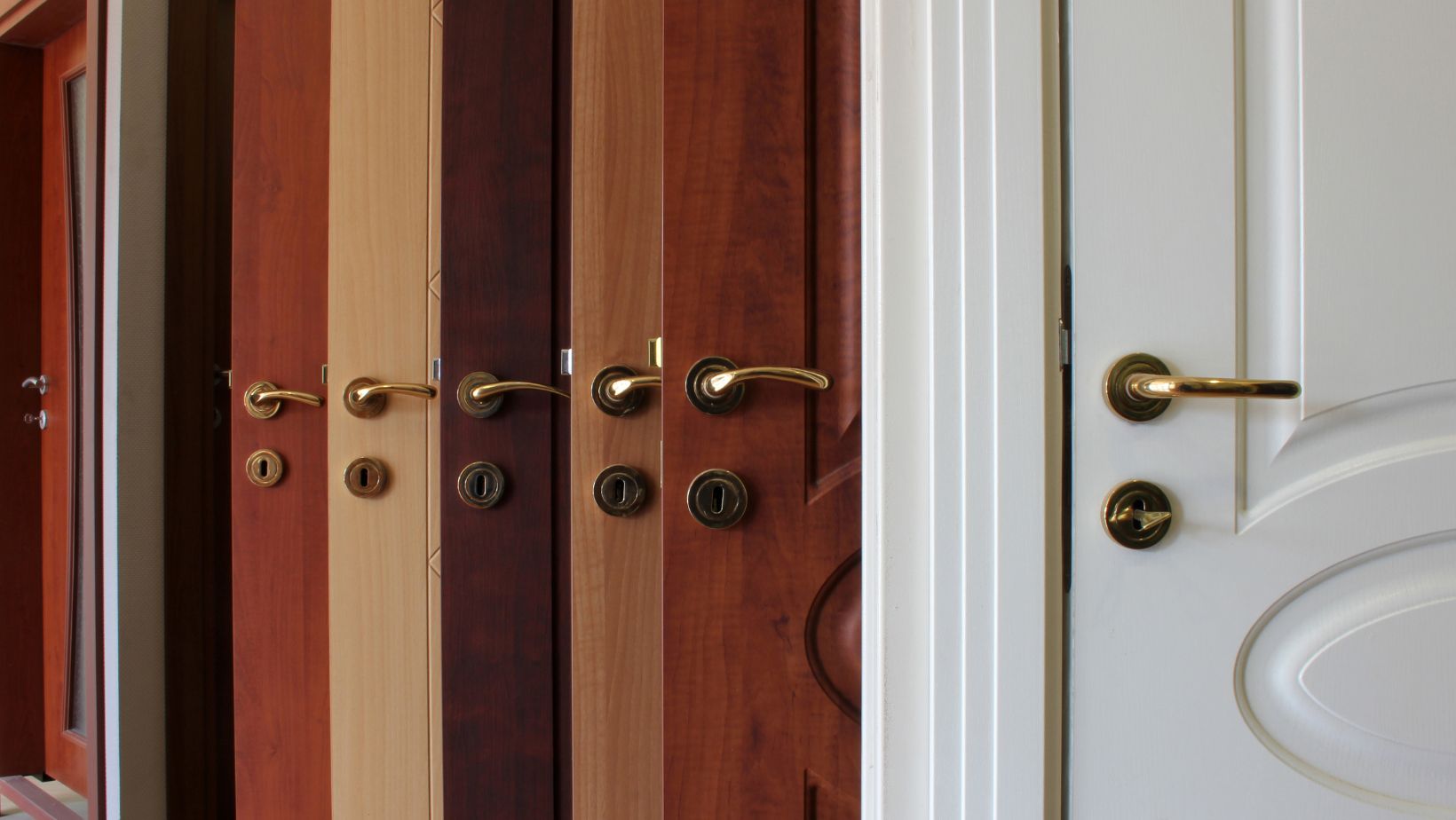Commercial solid-core wood doors are engineered with a dense interior core, often composed of wood-based materials such as particleboard, mineral core, or structural composite lumber. This core is sandwiched between high-quality wood veneers, giving the doors their characteristic strength and premium appearance. Unlike hollow-core alternatives, which may suffice in residential settings, solid-core wood doors are built to endure the heavier demands of commercial and institutional use.
One of the primary advantages of this construction is durability. In high-traffic environments—such as schools, hospitals, and office buildings—doors must resist frequent use, occasional abuse, and sometimes harsh environmental conditions. Solid-core doors perform exceptionally well under these pressures. Their robust structure minimizes the risk of dents, warping, and long-term degradation, which are common issues with lighter or hollow doors.
From a design perspective, solid-core wood doors offer the added benefit of aesthetic versatility. The outer veneers can be selected to match virtually any architectural style, from classic oak to sleek walnut. This flexibility allows architects and designers to maintain visual continuity without compromising the door’s structural integrity. In spaces where both form and function matter, such as hotels or executive offices, this blend of resilience and refinement is particularly valuable.
Enhanced Security and Protection
Security is a core concern in commercial design, and the solid-core door delivers impressively in this domain. The density of the core material adds substantial resistance against forced entry, making it a preferred option for businesses that prioritize safeguarding personnel and property. While no door is entirely impervious, solid-core models significantly increase the time and effort required for a breach, offering a critical window for security responses.
Beyond break-in resistance, solid-core doors also provide an effective barrier against accidental impacts. Whether from rolling carts in a hospital corridor or busy employees in a warehouse, the door’s weight and material composition absorb and distribute force, preventing splintering or frame separation. This added protection is especially relevant in environments where safety regulations and liability concerns play a major role.
Another vital component of protection is fire resistance. Many solid-core commercial doors are fire-rated, meaning they have been tested to contain fire and smoke for a designated period. While the specific fire rating depends on the core material and construction details, this capability can be crucial in ensuring the safety of building occupants during emergencies. The extra investment in fire-rated solid-core wood doors often translates into significant peace of mind and compliance with local codes.
Acoustic and Thermal Insulation
In addition to their structural benefits, solid-core wood doors are prized for their acoustic insulation. The dense material within the core acts as a natural sound barrier, making these doors a preferred choice in settings where noise control is essential. Conference rooms, legal offices, classrooms, and medical consultation areas can all benefit from the reduced transmission of sound, contributing to a more private and focused environment.
Thermal insulation is another often-overlooked feature that brings long-term value. The mass of a solid-core door helps to stabilize interior temperatures by slowing the transfer of heat between rooms or between indoors and outdoors. This quality not only enhances comfort for occupants but can also contribute to lower energy costs over time. In large commercial buildings, even small improvements in thermal efficiency can yield measurable savings.
Notably, many nationwide distributors offer premium-grade solid-core options tailored to these performance needs. For instance, a well-regarded supplier such as USA Fire Door provides a broad selection of solid core wood door solutions, engineered to meet both code and design specifications. With fire ratings, acoustic properties, and aesthetic options available, these doors are suited for a wide range of commercial applications, combining function with form.
Long-Term Cost Efficiency
While the upfront cost of solid-core wood doors may exceed that of their hollow-core or metal counterparts, the long-term economic value often justifies the initial investment. One of the most significant contributors to this value is longevity. Thanks to their robust construction, solid-core doors tend to outlast alternatives by many years, even under intensive use. This means fewer replacements and less frequent maintenance over the life of the door.
Repairs, when needed, also tend to be less costly. The thickness of the wood allows for sanding, refinishing, and minor structural restoration, rather than requiring a full door replacement. This extends not only the physical life of the door but also its visual appeal. Facilities managers and property owners often find that investing in durability on the front end reduces operational disruptions and future capital expenditures.
Moreover, the added benefits of thermal efficiency and sound control can contribute to lower operating costs and increased tenant or employee satisfaction. These indirect savings, though harder to quantify upfront, accumulate over time. When factoring in safety features such as fire ratings and security enhancements, the broader cost-benefit analysis becomes even more compelling. In effect, a solid-core wood door is not just a purchase, but a long-term asset.
Design and Customization Options
A key reason architects and designers favor solid-core wood doors in commercial builds is the wide range of customization options they offer. Whether the project calls for traditional elegance or modern minimalism, these doors can be crafted to align with nearly any interior scheme. The outer veneer is available in a variety of species and finishes, allowing it to blend seamlessly with walls, furniture, and trim.
Hardware compatibility also plays a role in customization. Solid-core doors can support a diverse array of locks, closers, handles, and automated systems. This makes them ideal for spaces requiring specialized security or access control measures. Whether outfitting a secure laboratory or a hotel suite, the door can be tailored to perform multiple functions while maintaining a cohesive appearance.
Additionally, these doors can be ordered in custom dimensions and configurations, including vision panels, louvers, and sidelights. This adaptability ensures they can be used across diverse building types, from educational campuses to high-rise office towers. The result is a product that doesn’t force compromise between safety, functionality, and aesthetic intention.
Compliance and Building Code Alignment
Commercial building codes are rigorous, and non-compliance can have serious consequences ranging from project delays to legal penalties. Solid-core wood doors, especially when specified with fire ratings and proper hardware, offer a straightforward path to code alignment. Whether it’s local fire ordinances or ADA accessibility standards, these doors can be configured to meet a broad range of requirements.
In environments like healthcare and education, where regulatory oversight is especially strict, having a door solution that satisfies all necessary certifications is invaluable. Many solid-core doors are tested under ANSI/SDI, NFPA, and UL standards, ensuring they are compliant across jurisdictions. Builders and specifiers can thus proceed with confidence, knowing their materials will pass inspection.
Furthermore, sourcing doors that are pre-approved for compliance can simplify the procurement process. Manufacturers and distributors often provide documentation and installation support that streamlines the approval pipeline. This reduces administrative burden and mitigates risk, reinforcing the solid-core wood door as a smart investment not only in terms of quality but also in operational efficiency.
Sustainability and Environmental Impact
Modern construction increasingly considers the environmental impact of materials used, and solid-core wood doors fare well in this regard when sourced responsibly. Many are manufactured using FSC-certified wood and low-emission adhesives, contributing to a project’s eligibility for LEED or other green building certifications. These sustainability credentials are becoming more important to developers, especially in corporate or government builds.
Durability also plays a role in environmental stewardship. A longer product lifecycle means fewer replacements, which translates to reduced resource consumption over time. This is in contrast to lighter or lower-cost doors that may need replacement within a few years, contributing to material waste and increased carbon footprints from manufacturing and transportation.
Finally, wood is a renewable resource, and advances in harvesting and manufacturing practices have made it possible to source solid-core wood doors with minimal ecological disruption. By choosing these doors, property owners and developers are not just improving their buildings—they are making a responsible choice that reflects well on their broader commitment to sustainability and corporate responsibility.

















